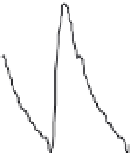Biomedical Engineering Reference
In-Depth Information
the signal into a 2D function of time and frequency. The transform is described mathemat-
ically as
1
x
ð
t
Þ
g
ð
t
a
Þ
e
j
o
t
dt
X
ð
o,
a
Þ¼
ð
11
:
55
Þ
1
where
g
(
t
) may define a simple box or pulse function. The inverse of the STFT is given as
ðð
a
Þ
g
ð
t
a
Þ
e
j
o
t
dtda
X
ð
o,
a
Þ¼
K
g
X
ð
o,
ð
11
:
56
Þ
where
K
g
is a function of the window used.
To avoid the “boxcar” or “rippling” effect associated with a sharp window, the window
may be modified to have more gradually tapered sides. Both designs are shown in
Figure 11.29. The windows are superimposed on a totally periodic aortic pressure signal.
For clarity, the windows have been multiplied by a factor of 100.
The STFT amplitudes for three box window sizes, ½ period, 1 period, and 2 periods,
are illustrated in Figure 11.30. The vertical lines in the top figure are indicative of longer
periodicities than the window. The solid-colored horizontal lines in the bottom two
figures indicate that the frequency content is totally independent of time at that
window size. This is expected, since the window includes either one or two perfect
periods. The dark (little or no frequency content) horizontal lines interspersed with
the light lines in the bottom figure indicate that multiple periods exist within the
window.
PERIODIC PRESSURE WAVEFORM (mmHG)
120
100
80
60
40
20
0
0
1
2
3
4
5
6
TIME (s)
FIGURE 11.29
An example of two windows that might be used to perform an STFT on a perfectly periodic
aortic pressure waveform. Each window approximates the width of one pulse. The tapered window on the left
can help avoid the “boxcar” or “rippling” effect associated with the sharp window on the right. For clarity, the
windows have been multiplied by a factor of 100.






























